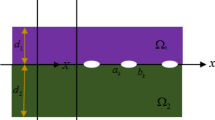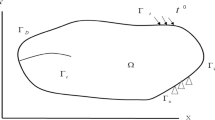Abstract
In fracture analysis of piezoelectric devices, the structural dimension is often assumed to be infinite at least in one direction. However, all practical piezoelectric structures are finite and their dimensions in different directions are often comparable and cannot be simplified as infinite. The assumption of infinite dimension may lead to inexact theoretical results. The present work aims at studying the interfacial fracture behavior of a functionally graded piezoelectric layer on a dielectric substrate with finite dimension. The crack problem is solved by the methods of Fourier series and Cauchy singular integral equation. Parametric studies on the stress intensity factor (SIF) reveal the following: (a) when a crack tip is near to an interface end, its SIF is mainly governed by the end effect; (b) when a crack is far from the interface ends and the piezoelectric layer is thin, its SIF is principally affected by the thickness of the piezoelectric layer, and (c) only when a crack is far from the interface ends and meanwhile the piezoelectric layer is thick will its SIF be dominated by the non-homogeneity parameter, and in this case, the SIF increases with the increasing non-homogeneity parameter.
Similar content being viewed by others
References
Zimmermann C., Rebiere D., Dejous C., Pistre J., Chastain E., Planade R.: A Love wave gas sensor coated with functionalized polysiloxane for sensing organophosphorus compounds. Sens. Actuators B 76, 88–94 (2001)
Li Y.D., Lee K.Y.: Dynamic responses of a crack in a layered graded magnetoelectroelastic sensor subjected to harmonic waves. Acta Mech. 204, 217–234 (2009)
Wang X.Y., Yu S.W.: Transient response of a crack in piezoelectric strip subjected to the mechanical and electrical impacts: mode-III problem. Int. J. Solid. Struct. 37, 5795–5808 (2000)
Li X.F., Lee K.Y.: Electroelastic behavior of a rectangular piezoelectric ceramic with an antiplane shear crack at arbitrary position. Euro. J. Mech. A/Solid. 23, 645–658 (2004)
Parton V.Z.: Fracture mechanics of piezoelectric materials. Acta Astronaut. 3, 671–683 (1976)
Suo Z., Kuo C.M., Barnett D.M., Willis J.R.: Fracture mechanics for piezoelectric ceramics. J. Mech. Phys. Solid. 40, 739–765 (1992)
Hao T.H., Shen Z.Y.: A new electric boundary condition of electric fracture mechanics and its applications. Eng. Fract. Mech. 47, 793–802 (1994)
Zhou Z.G., Wang B.: Two parallel symmetry permeable cracks in functionally graded piezoelectric/piezomagnetic materials under anti-plane shear loading. Int. J. Solid. Struct. 41, 4407–4422 (2004)
Wang B.L., Mai Y.W.: Impermeable crack and permeable crack assumptions, which one is more realistic?. J. Appl. Mech. 71, 575–578 (2004)
Zhou Z.G., Wang B.: The behavior of two parallel symmetry permeable interface cracks in a piezoelectric layer bonded to two half piezoelectric materials planes. Int. J. Solid. Struct. 39, 4485–4500 (2002)
Zhang T.Y., Tong P.: Fracture mechanics for a mode III crack in a piezoelectric material. Int. J. Solid. Struct. 33, 343–359 (1996)
Park S., Sun C.T.: Fracture criteria for piezoelectric ceramics. J. Am. Ceram. Soc. 78, 1475–1480 (1995)
Zuo J.Z., Sih G.C.: Energy density theory formulation and interpretation of cracking behavior for piezoelectric ceramics. Theor. Appl. Fract. Mech. 34, 17–33 (2000)
Feng W.J., Su R.K.L.: Dynamic internal crack problem of a functionally graded magneto-electro-elastic strip. Int. J. Solid. Struct. 43, 5196–5216 (2006)
Shin J.W., Lee K.Y.: Eccentric crack in a piezoelectric strip bonded to half planes. Euro. J. Mech. A/Solid. 19, 989–997 (2000)
Li Y.D., Lee K.Y.: Fracture analysis and improved design for a symmetrically bonded smart structure with linearly non-homogeneous magnetoelectroelastic properties. Eng. Fract. Mech. 75, 3161–3172 (2008)
Li Y.D., Lee K.Y.: Anti-plane crack intersecting the interface in a bonded smart structure with graded magnetoelectroelastic properties. Theor. Appl. Fract. Mech. 50, 235–242 (2008)
Li Y.D., Lee K.Y.: Anti-plane fracture analysis for the weak-discontinuous interface in a non-homogeneous piezoelectric bi-material structure. Euro. J. Mech. A/Solid. 28, 241–247 (2009)
Li Y.D., Lee K.Y.: Interaction between an electrically permeable crack and the imperfect interface in a functionally graded piezoelectric sensor. Int. J. Eng. Sci. 47, 363–371 (2009)
Li X.F., Xu L.R.: Transient response of a finite bimaterial plate containing a crack perpendicular to and terminating at the interface. J. Appl. Mech. 73, 544–554 (2006)
Li X.F., Duan X.Y.: An interfacially-cracked orthotropic rectangular bi-material subjected to antiplane shear loading. Appl. Math. Comput. 174, 1060–1079 (2006)
Li X.F., Guo S.H.: Effects of nonhomogeneity on dynamic stress intensity factors for an antiplane interface crack in a functionally graded material bonded to an elastic semi-strip. Comput. Mater. Sci. 38, 432–441 (2006)
Gradshteyn I.S., Ryzhik I.M.: Table of Integrals, Series and Products. Academic Press, New York (1980)
Li Y.D., Lee K.Y.: Fracture analysis on the arc-shaped interface in a layered cylindrical piezoelectric sensor polarized along its axis. Eng. Fract. Mech. 76, 2065–2073 (2009)
Erdogan F., Gupta G.D.: On the numerical solution of singular integral equations. Quart. Appl. Math. 29, 525–534 (1972)
Author information
Authors and Affiliations
Corresponding author
Rights and permissions
About this article
Cite this article
Li, YD., Lee, K.Y. Interfacial fracture analysis of a graded piezoelectric layer on a substrate with finite dimension. Arch Appl Mech 80, 1007–1016 (2010). https://doi.org/10.1007/s00419-009-0356-4
Received:
Accepted:
Published:
Issue Date:
DOI: https://doi.org/10.1007/s00419-009-0356-4




